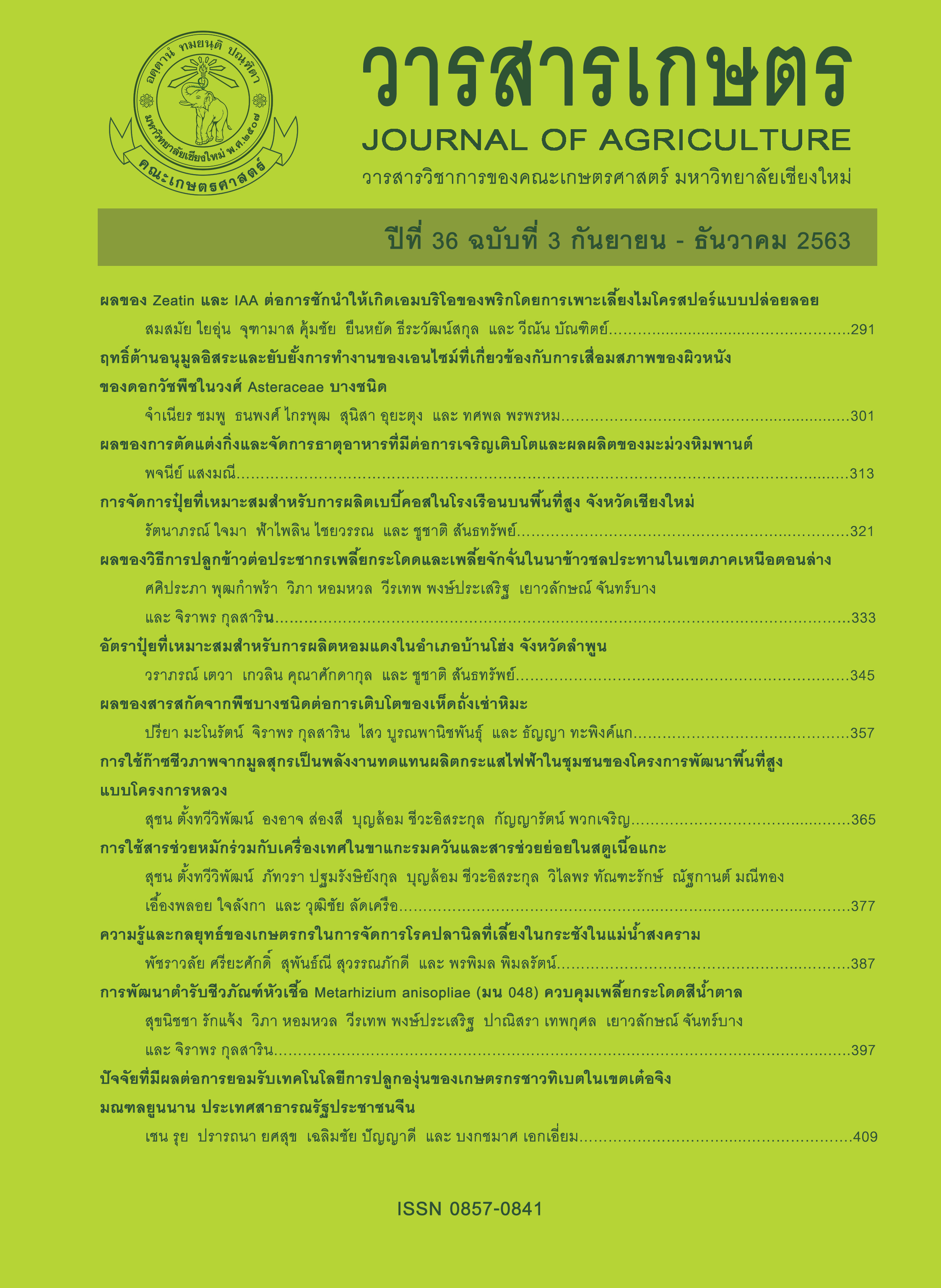ผลของวิธีการปลูกข้าวต่อประชากรเพลี้ยกระโดดและเพลี้ยจักจั่นในนาข้าวชลประทานในเขตภาคเหนือตอนล่าง
Main Article Content
บทคัดย่อ
การศึกษาครั้งนี้มีวัตถุประสงค์ เพื่อศึกษา วิธีการปลูกข้าว พันธุ์ กข49 จำนวน 5 วิธี ได้แก่ นาหว่านน้ำตม นาหยอดข้าวงอก นาโยน นาปักดำด้วยมือ และนาปักดำด้วยเครื่อง ที่มีผลต่อการเปลี่ยนแปลงประชากรของเพลี้ยกระโดดและเพลี้ยจักจั่น ระหว่างเดือน มิถุนายน-กันยายน 2561 ในพื้นที่ตำบลบึงบัว อำเภอวชิรบารมี จังหวัดพิจิตร โดยการสุ่มนับแมลงโดยตรง ทุก 7 วัน ตั้งแต่ข้าวอายุ 15 วัน ตลอดฤดูปลูก พบว่า ในทุกวิธีการปลูก พบเพลี้ยกระโดดสีน้ำตาล เพลี้ยกระโดดหลังขาว เพลี้ยจักจั่นปีกลายหยัก เพลี้ยจักจั่นสีเขียวและเพลี้ยจักจั่นขาวใหญ่ แต่มีเพียงเพลี้ยกระโดดสีน้ำตาลและเพลี้ยจักจั่นสีเขียวเท่านั้นที่พบจำนวนมากและมีการเปลี่ยนแปลงประชากรอย่างชัดเจนตลอดฤดูปลูก ในวิธีการปลูกแบบนาหว่าน้ำตม พบประชากรของเพลี้ยกระโดดสีน้ำตาลสูงที่สุด จำนวน 199.05 ตัวต่อตารางเมตร ในขณะที่ วิธีการปลูกแบบปักดำด้วยเครื่อง พบประชากรเพลี้ยจักจั่นสีเขียวสูงที่สุด จำนวน 101.95 ตัวต่อตารางเมตร โดยความหนาแน่นของต้นข้าวต่อตารางเมตรมีผลต่อการเพิ่มขึ้นของประชากรของเพลี้ยกระโดดสีน้ำตาลมากที่สุดถึงร้อยละ 97.09 แต่มีผลต่อเพลี้ยจักจั่นสีเขียวน้อยมาก ส่วนปัจจัยทางกายภาพของสภาพแวดล้อม พบว่า มีอิทธิพลต่อเพลี้ยทั้งสองชนิด น้อยมาก อยู่ในช่วงร้อยละ 0-45 ในทุกวิธีการปลูก
Article Details
เอกสารอ้างอิง
Anuson, P., W. Chamnan and P. Rattana. 2015. Survey of insect pests in rice irrigated in Saraburi province. pp.196-207. In: Proceedings of 8th Seminar on Rice: Upper and Lower Northern Rice Research Centers. Rice Department, Bangkok. (in Thai)
Dale, D. 1994. Insect pests of the rice plant--their biology and ecology. pp.363-485. In: E.A. Heinrichs (ed.). Biology and Management of Rice Insects. Wiley, New York.
Dyck, V. A.1974. Field control of the brown planthopper, Nilaparvata lugens in the tropics. Rice Entomology Newsletter 1: 22-24.
Fernando, H.E. 1975. The brown planthopper problem in Sri Lanka. Rice Entomology Newsletter 2: 34-36.
Gurr, G.M., J. Liu, D.M.Y. Read, J.L.A. Catindig, J.A. Cheng, L.P. Lan and K.L. Heong. 2011. Parasitoids of Asian rice planthopper (Hemiptera: Delphacidae) pests and prospects for enhancing biological control by ecological engineering. Annals of Applied Biology 158(2): 149-176.
International Rice Research Institute (IRRI). 1972. Annual Report for 1972. International Rice Research Institute, Los Banos. 238 p.
Kuno, E. and N. Hokyo. 1970. Comparative analysis of the population dynamics of rice leafhoppers, Nephotettix cincticeps Uhler and Nilaparvata lugens Stal, with special reference to natural regulation of their numbers. Researches on Population Ecology 12(2): 154-184.
Lu, Z.X., S. Villareal, X.P. Yu, K.L. Heong and C. Hu. 2006. Biodiversity and dynamics of planthoppers and their natural enemies in rice fields with different nitrogen regimes. Rice Science 13(3): 218-226.
Mani, M. and S. Jayaraj. 1976. Biological investigations on the resurgence of the rice blue leafhopper, Zygina maculifrons (Motch.) Indian Journal of Experimental Biology 14: 636-637.
Mansor, M.H. and A.B. Idris. 2014. Temporal population abundance of leafhopper (Homoptera: Cicadelidae) and planthopper (Homoptera: Delphacidae) as affected by temperature, humidity and rice growth stages. Academic Journal of Entomology 7(1): 01-06.
Moldenhauer, K. and N. Slaton. 2004. Rice growth and development. pp.7-14. In: N.A. Slaton, L.B. Ford, J.L. Bernhardt, R.D. Cartwright, D. Gardisser, J. Gibbons, G. Huitink, B. Koen, F.N. Lee, D.M. Miller, R.J. Normam and T. Siebenmorgen (eds.). Rice Production Handbook. Division of Agriculture, University of Kansas, Lawrence, KS.
Nishida, T. 1975. Causes of brown planthopper outbreaks. Rice Entomology Newsletter 2: 38.
Norowi, H.M. 2001. Simulation of brown planthopper damage mechanism on rice. Journal of Tropical Agriculture and Food Science 29(1): 39-51.
Pathak, M.D. and V.A. Dyck. 1973. Developing an integrated method of rice insect pest control. Pest Articles & News Summaries 19(4): 534-544.
Patirupanusara, T. and P. Patirupanusara. 2012. Rice Pests and Natural Enemies in the Lower Northern and Upper Central Thailand. Bureau of Rice Research and Development, Rice Department, Bangkok. 303 p. (in Thai)
Rachappa, V., S. Yelshetty, S. Vennila, O.P. Sharma and S. Patil. 2016. Influence of climate change on occurrence of green leafhopper Empoasca kerri Pruthi on pigeonpea. Journal of Experimental Zoology, India 19(2): 1163-1166.
Ramya, M., J.S. Kennedy, V.G. Lakshmi, A. Lakshmanan, N. Manikandan and N.U. Sekhar. 2012. Impact of elevated temperature on major pests of rice. Climarice Technical Brief 10. Chimarice, Tami Nadu, India. 6p.
Ruay-aree, S. and R. Surakarn.1999. Rice cultivation system and forecasting the outbreak insect pests based on light trap data. Entomology and Zoology Gazette 21(2): 108-110. (in Thai)
Rubia-Sanchez, E., Y. Suzuki, K. Arimura, K. Miyamoto, M. Matsumura and T. Watanabe. 2003. Comparing Nilaparvata lugens (Stål) and Sogatella furcifera (Horvath) (Homoptera: Delphacidae) feeding effects on rice plant growth processes at the vegetative stage. Crop Protection 22(7): 967-974.
Settle, W.H., H. Ariawan, E.T. Astuti, W. Cahyana, A.L. Hakim, D. Hindayana, A.S. Lestari and Pajarningsih. 1996. Managing tropical rice pests through conservation of generalist natural enemies and alternative prey. Ecology 77(7): 1975-1988.
Soinark, V., W. Pongprasert, S. Tanasinchayakul, W. Sorapongpisal and K. Kertsuk. 2015. Insect and spider diversity in irrigated paddy fields at Phitsanulok province. Journal of Agriculture 31(3): 281-290.
Xu, S., H. Wang, E. Wang and G. Zhao. 2013. Reproductive rate of rice brown planthopper population of super rice Yongyou 6. Advance Journal of Food Science and Technology 5(5): 539-542.
Yusof, T.N.B.T. 2018. Effects of temperature and relative humidity on growth of green leafhopper (Nephotettix virescens Distant). M.S. Thesis. University Putra Malaysia, Selangor. 62 p.


